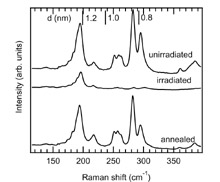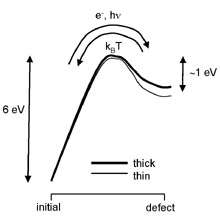Materials Science Laboratory
Single-walled carbon nanotubes (SWNTs) are promising material as a
constituent of future nano-electronics because of their nanometer-scale
diameter and excellent electric, chemical, and mechanical properties. We
have reported that SWNTs are damaged by low-energy electron and photon
irradiation and that their electric properties are largely altered from
metallic to semiconducting, or even to insulating, by moderate damage [1].
Recently, we have found that defects induced by low-energy irradiation
have some unique characteristics.
In the case of knock-on damage caused by high-energy particle irradiation,
the SWNTs can not be fully recovered by annealing because ejected atoms
are lost. On the other hand, one of important properties of low-energy
irradiation damage is that the SWNTs can recover [2]. Raman spectra (radial
breathing mode [RBM] region) of pristine, irradiated, and annealed SWNTs
are shown in Fig. 1. The RBM frequency depends on the diameter, and thinner
nanotubes have larger frequencies. All of the RBM peaks disappeared except
for that of the thickest SWNTs, but they reappeared after annealing. This
indicates that the number of carbon atoms remains constant with defect
formation. Our results also reveal that the damage and recovery strongly
depends on the diameter: that is, thinner SWNTs are more easily damaged
and hardly recover (see Fig. 1). Moreover, the damaged SWNTs were found
to recover even at room temperature or below. The activation energy of
the defect healing was estimated to be about 1 eV (depending on the diameter)
by observing recovery process by means of electric conductivity [3]. Whereas,
the threshold energy of defect formation was determined to be about 6 eV
from the results of monochromated vacuum ultra-violet light irradiation
experiments. The energetics of the defect formation and healing is summarized
in Fig. 2. We will try to determine the detailed atomic structure of the
defects and to control the device performance by defect engineering.
[1] A. Vijayaraghavan, et al., Nano Lett. 5 (2005) 1575.
[2] S. Suzuki and Y. Kobayashi, Chem. Phys. Lett. 430 (2006) 370.
[3] S. Suzuki and Y. Kobayashi, J. Phys. Chem. C 111 (2007) 4524.
 |
 |
|||||
|
|